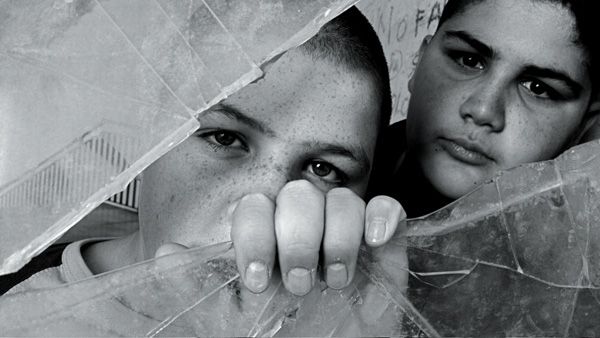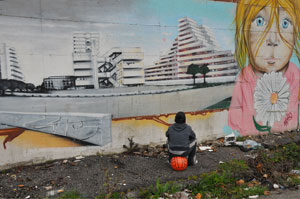The Child Soldiers of Scampia
The Child Soldiers of Scampia
(June 29, 2010)
Davide Cerullo comes from the gangland of Scampia, Naples. Once a drug hustler, he finally rebelled to the "easy life" the Camorra offered him: "Give people an opportunity, and real miracles can happen." Co-author of "Ali Bruciate, I bambini di Scampia" (Burnt Wings, The Children of Scampia), he is exhibiting his photographs of these child soldiers at the "Casa della Memoria e della Storia," Rome (7/2-10/22)
The beauty of Naples was once so inspiring that, at sight of its transparent gulf waters and palm parks and handsome youth, the 18th Century German poet Goethe exclaimed, “See Naples and then die!” The phrase lent itself to twisting, and in later times came to insinuate the dark side of Naples, as in Elmer Rice’s 1929 Broadway play "See Naples and Die" starrin
g Claudette Colbert. Today, the upside-down title referring to the sinister Neapolitan half-life continues to endure in movies, novels and scholarly works, most recently referring to the violent and drug-ridden Rione Scampia quarter, Italy’s Ciudad Juarez.
 |
| "Le Vele" in a mural |
Seen from the air, Naples is shaped rather like a butterfly. Goethe’s beautiful gulf shapes its tail; the postwar bedroom suburb of Scampia, jerry-built in the 1970s and 1980s, its head. With at least 50% unemployment (the figure is higher still among youth), Scampia is home to some 50,000. Although originally planned to provide public housing, including for earthquake victims, it had poor transportation facilities into central Naples and quickly became a center for the organized crime gangs of the Camorra. Their capital in Scampia is the vast beehive of 20-story apartment blocks set in a treeless waste. Known as Le Vele (The Sails), they would be scorned by today’s architectural aesthetes as a misunderstanding of modernity in construction; indeed a few have been demolished. In this, Naples is hardly alone; the same social and economic problems aggravated by architecturally-driven alienation arose in the densely-inhabited, crime-ridden high-rise buildings constructed in Britain in the same period.
Buses bring drug users from many miles away to Scampia, where they stock up on cocaine, crack, marijuana, heroin and its nasty smokable sub-species called Kobret; this reporter has seen two youngsters shooting heroin directly into the vein. Overdoses are frequent. Said one student who lives in Scampia: “Our parents are frightened when we go off to school. This is no man’s land.” Addicts admit they pay for their habit by stealing cell phones, bicycles and motor bikes (a motor bike brings E 100, or $125).
Davide Cerullo was one of  fourteen sisters and brothers who were born and raised in the gangland turmoil of Scampia, where he has lived for twenty-five years. At fourteen he began hustling drugs, earning, he says, up to E. 500 (about $650) a day. In the bad times he was tossed into a prison cell. During one of his several prison stints, he found on a bunk bed a copy of the Bible. “I opened it, and in it I found, repeated again and again, my own name, Davide. It triggered something in me.”
fourteen sisters and brothers who were born and raised in the gangland turmoil of Scampia, where he has lived for twenty-five years. At fourteen he began hustling drugs, earning, he says, up to E. 500 (about $650) a day. In the bad times he was tossed into a prison cell. During one of his several prison stints, he found on a bunk bed a copy of the Bible. “I opened it, and in it I found, repeated again and again, my own name, Davide. It triggered something in me.”
 fourteen sisters and brothers who were born and raised in the gangland turmoil of Scampia, where he has lived for twenty-five years. At fourteen he began hustling drugs, earning, he says, up to E. 500 (about $650) a day. In the bad times he was tossed into a prison cell. During one of his several prison stints, he found on a bunk bed a copy of the Bible. “I opened it, and in it I found, repeated again and again, my own name, Davide. It triggered something in me.”
fourteen sisters and brothers who were born and raised in the gangland turmoil of Scampia, where he has lived for twenty-five years. At fourteen he began hustling drugs, earning, he says, up to E. 500 (about $650) a day. In the bad times he was tossed into a prison cell. During one of his several prison stints, he found on a bunk bed a copy of the Bible. “I opened it, and in it I found, repeated again and again, my own name, Davide. It triggered something in me.”The experience turned his life around. “Poetry and art became my passport to a better life…. I began to take photographs first because I stopped the image in my mind, and then I reflected upon the world [through it]. Even if we make mistakes it’s not true than an individual can’t be saved. The unsalvageable is only an invention in bad faith, that makes us think that all is lost. Give people an opportunity, and real miracles can happen,” he said in a recent interview in Panorama magazine.
This week Cerullo’s book on the child soldiers of the Camorra, Ali Bruciate, I bambini di Scampia (Burnt Wings, The Children of Scampia), written together with Don Alessandro Pronzato, priest and author, is being presented in Rome (Edizioni Paoline). An exhibition of his photographs of the children of Scampia will be on view through October 22 in Trastevere at the Casa della Memoria e della Storia di Roma, Via San Francesco di Sales, 5 (summer closing Aug. 1-31).
DISCLAIMER: Posts published in i-Italy are intended to stimulate a debate in the Italian and Italian-American Community and sometimes deal with controversial issues. The Editors are not responsible for, nor necessarily in agreement with the views presented by individual contributors.
© ALL RIGHTS RESERVED - RIPRODUZIONE VIETATA.This work may not be reproduced, in whole or in part, without prior written permission.
Questo lavoro non può essere riprodotto, in tutto o in parte, senza permesso scritto.
Add a comment



